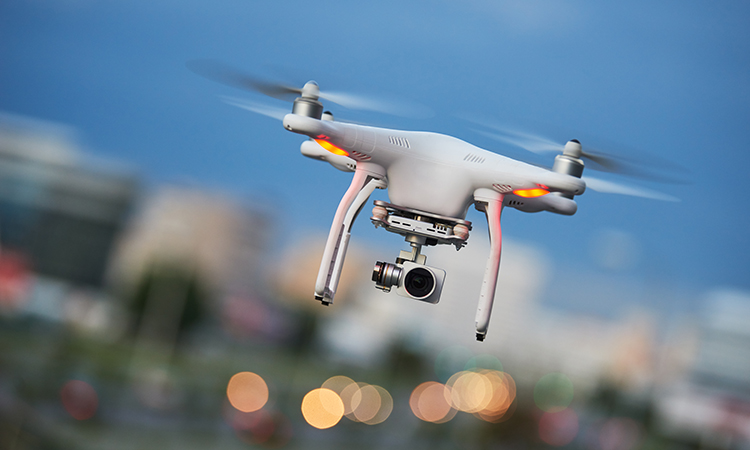Sarah Vanessa Poralla, Aerodrome Expert at the European Union Aviation Safety Agency (EASA), and Dr.-Ing. Veit Voges, Senior Project Leader of Flight Ops Engineering at Zurich Airport, explore the threat posed by drones in the airport environment, and what can be done to prevent, mitigate and learn from them.
In the next five to 10 years, Europe will see the safe, secure and efficient integration of Unmanned Aircraft Systems (UAS) – also referred to as drones – into the airspace, where they will be operated alongside manned aircraft, such as in the airport environment. This necessitates the introduction of additional specific rules and procedures for UAS operations and the organisations involved in those operations, as well as a high degree of automation and digitalisation. This ‘U-space’ is a combination of U-space services, volumes of airspace and information exchange to support the air traffic management (ATM) of UAS and mitigate the risks of collision between the different UAS, as well as between UAS and manned aircraft in the shared U-space airspace.
In the next five to 10 years, Europe will see the safe, secure and efficient integration of Unmanned Aircraft Systems into the airspace, where they will be operated alongside manned aircraft”
The European Union (EU) has adopted common European rules that are applicable to drones and are found in Regulation (EU) 2019/947 on the rules and procedures for the operation of UAS, and Regulation (EU) 2019/945 on UAS and third-country operators of UAS. The rules aim to strike a balance between the opportunities offered by drones and the necessary obligations on drone manufacturers and operators, in terms of safety, respect for privacy, the environment, protection against noise and public security. The new rules ensure that drone operators – whether for recreational or professional use – will have a clear understanding of what is and is not allowed.
However, drones have evolved into a constant threat at airports in the last few years, and the defined rules cannot always prevent unintentional operations near aerodromes, nor obviously those for intentional or malicious purposes.
Zurich Airport (ZRH) is facing around two to three incidents per month where an unauthorised drone is seen, and a report is made to airport security or the police. While, fortunately, there has not been a major incident with long interruptions of traffic, other examples in Europe and worldwide highlight the constant threat due to drone sightings and the evolving situation – the major events at Madrid–Barajas Airport (MAD) and Frankfurt Airport (FRA) in February and March 2020, respectively, are some such examples. Additionally, after having to accommodate VIP movements and state aircraft during the annual World Economic Forum, which was hosted in Davos in January 2021, Zurich Airport requires a sensitive mindset with respect to possible drone incidents and needs to know how to counter them effectively. Each airport will have a certain attentiveness to this nowadays.
At the beginning of most drone events, one is not aware if the drone is operated by a pilot motivated by negligence, gross negligence or even criminal intent”
At the beginning of most drone events, one is not aware if the drone is operated by a pilot motivated by negligence, gross negligence or even criminal intent. While the motive may differ substantially, the response triggered by the aviation community at airports is often similar and can result in major consequences for its operations. Information might be scarce and difficult to verify. The location of the drone might be hard to determine. New contradictory reports could come in. Time is running fast to react.
This ambiguity about a situation is a challenging task which needs to be solved as soon as possible in order to avoid long airport disruptions, flight cancellations and delays or, in the worst case, prevent a mid-air collision between the drone and a departing or landing aircraft.
A drone incident can combine aviation safety and security aspects or morph from one to the other. For this reason, a holistic approach is needed, encompassing both safety and security considerations.
In practice, it is very challenging to identify a drone and even more difficult to ascertain the motivation and intent of the perpetrator/ offender behind the incident. For this reason, it is necessary to consider all drone incident offender categories in all scenarios, to be developed as part of the risk assessment. Furthermore, it must be ensured that different types of motivations are considered as a possibility in the threat assessment during an incident, based on all available information. In accordance with the overall objective, all relevant actors should respond appropriately and quickly to mitigate or even neutralise the developing threat.
The preparation of an airport’s drone incident management is a multi-layered set of measures and activities. The key to being the most effective, however, is to start out by forming a joint working group with all stakeholders”
The preparation of an airport’s drone incident management is a multi-layered set of measures and activities. The key to being the most effective, however, is to start out by forming a joint working group with all stakeholders, e.g. law enforcement, air operators, airport steering, air traffic control (ATC) etc. This ensures the best understanding of the issue, most likely reflects all relevant aspects and provides a robust decision-making process that is needed in time-critical situations during an incident.
Throughout 2020, the European Union Aviation Safety Agency (EASA) worked with the Counter-UAS Task Force that it had formed to work on material to help aerodromes prepare for the misuse of drones in their surroundings. The task force combined expertise and knowledge from all relevant stakeholders – airports, air navigation service providers (ANSPs), air traffic control officers (ATCOs), air operators, DG HOME and DG MOVE, as well as law enforcement authorities – and provided an exceptional platform of interdisciplinary work to find effective solutions for the complex counter UAS problem.
Airports were represented in this group by Airports Council International (ACI) Europe and the member airports of AENA Spain, Frankfurt, Fraport Greece, Milan, Munich, Paris/ Groupe ADP and Zurich to provide first-hand industry experience and specific airport examples in the discussion.
The work results were compiled in a manual separated in three parts:
- Part 1: Drone Incident Management at Aerodromes – the challenge of unauthorised drones in the surroundings of aerodromes
- Part 2: Drone Incident Management at Aerodromes – guidance and recommendations
- Part 3: Drone Incident Management at Aerodromes – resources and practical tools.
Only Part 1 is publicly available on the EASA website. The full manual, containing all three parts, can be obtained upon request by aviation actors, law enforcement and national civil aviation authorities by contacting EASA.
While there will be no ‘silver bullet’ solution for all airports, the group has defined a process outline and threat zones in a generic way, which will be useful at multiple locations, to be reflected upon and used as a recommendation. The work provides guidance on how to develop appropriate arrangements and procedures which support an incident response that is quick, effective and proportionate. In this way, air traffic suspensions or airspace or runway closures may be avoided or kept to a minimum, and airport closure would remain a last resort.
source : https://www.internationalairportreview.com/article/156595/preparing-arrival-drones-airport-environment/?utm_source=Email+marketing&utm_medium=email&utm_campaign=IAR+-+2021+Content+highlights+email+-+18+May+2021&utm_term=Karima%2c+take+a+look+at+the+latest+content+from+the+airports+of+the+future%2c+plus+meet+the+new+Editor!&utm_content=https%3a%2f%2femails.internationalairportreview.com%2frussellpublishinglz%2f&gator_td=GiDw4EWkROGLfKHewsOA9ZtOzQH9%2bxLCMXpeng43CNmyRYIHnOQ6qjMGCIbJHb6cmcdBcY%2flgcED4qCmtotJEwKbF695SmjsStevUX7lSVgeM6jq8htPECT%2fVs6evgrpOABsNZJh6tOVemtPQD7hU15TOaRJoVDNp8KdAocXKhEBkcxwbOWbKvEtMSpaWtJ%2bNNP275lDBKu5e1BZ8bz9YhHQW6Jo1f%2fZb7SV335za9M%3d


